
http://www.mmdtkw.org/CNAf0701aAppianHistory.jpg
Appian based his history of the war on the mostly lost text of Polybius.
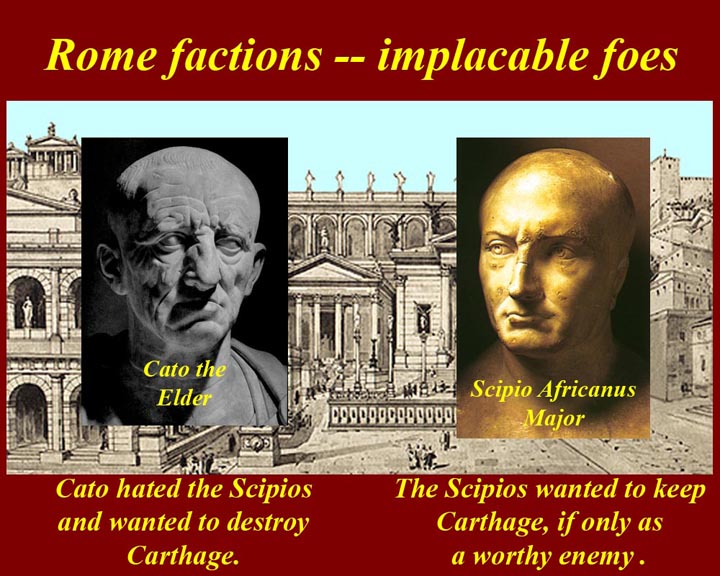
http://www.mmdtkw.org/CNAf0701bRomeFactionsCato-Scipios.jpg
Pro- and anti-war factions developed in Rome in the inter-war years.
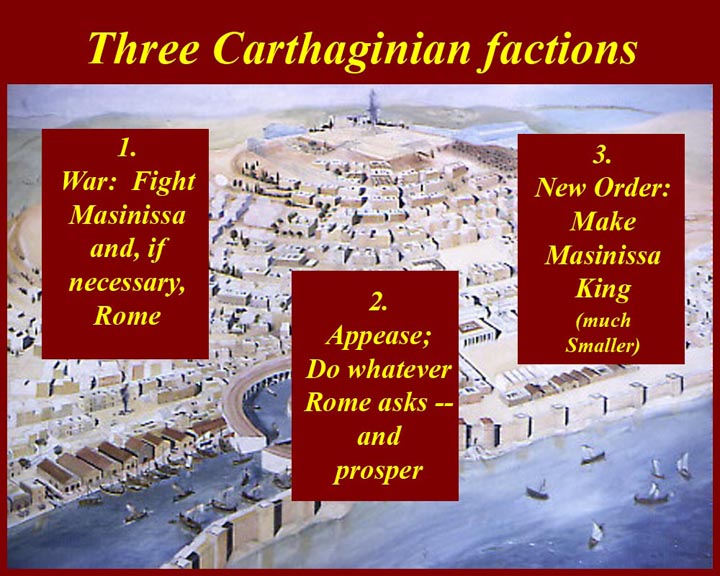
http://www.mmdtkw.org/CNAf0702ThreeCarthageFactions.jpg
Similar factions grew in Carthage where a small faction also developed that favored an new Numidian (Masinissa) monarchy.
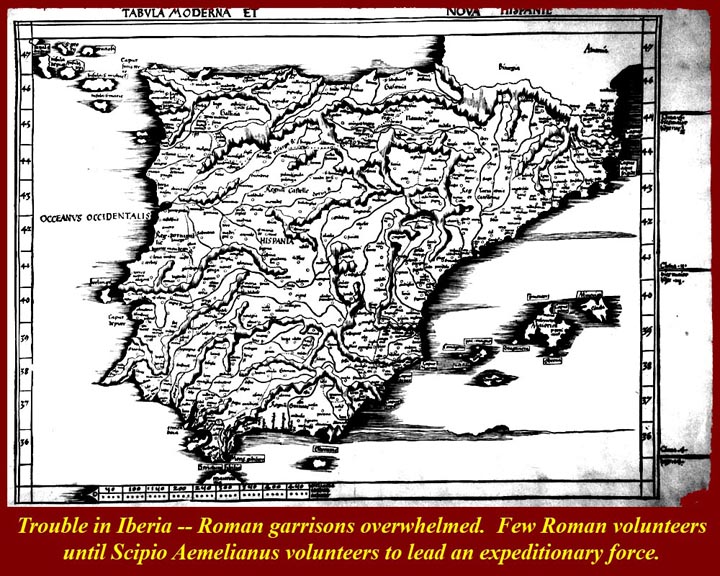
http://www.mmdtkw.org/CNAF0703IberiaTroubles.jpg
Between the Second and Third Punic wars, Roman control over Iberia slackened and revolts followed. Most Romans wouldn't volunteer for Iberian military duty -- until Scipio Aemilainus joined up.
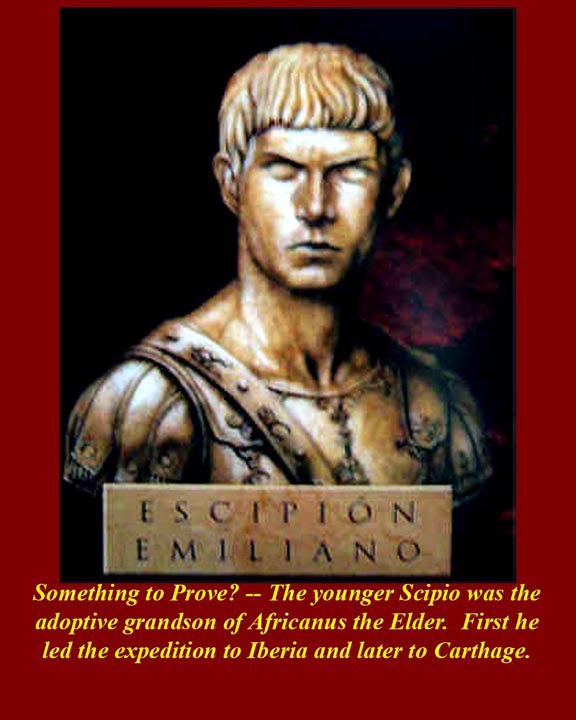
http://www.mmdtkw.org/CNAf0704YoungerScipio.jpg
Scipio Aemilianus, an adoptive grandson of Africanus, was the new star of the faction that thought war with Carthage was not necessary.
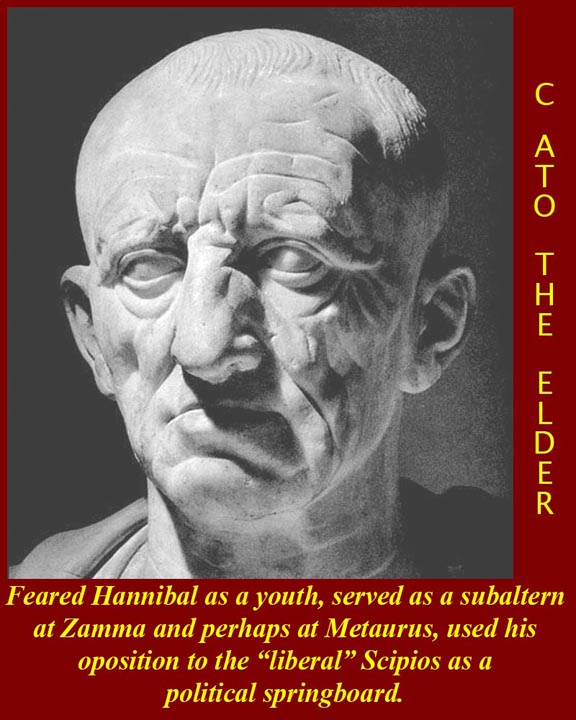
http://www.mmdtkw.org/CNAf0705CatoElder1.jpg
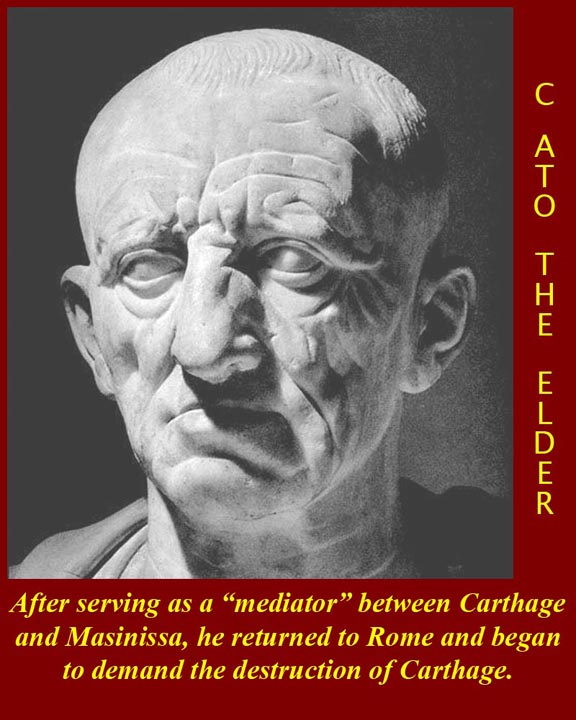
http://www.mmdtkw.org/CNAf0706CatoElder2.jpg
Cato the Elder, a veteran of the Second Punic War, was the iplacable foe of the Scipios and led the Roman faction that said war with Carthage was necessary for Rome's long term existence.
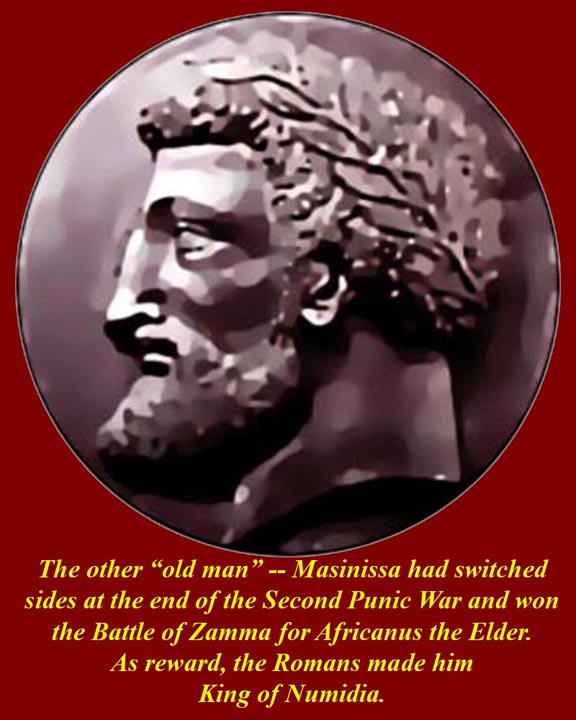
http://www.mmdtkw.org/CNAf0707Massinissa1.jpg
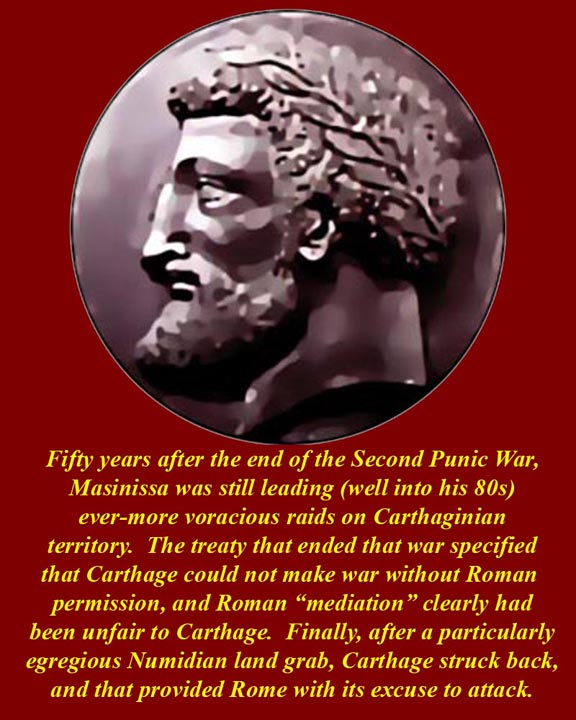
http://www.mmdtkw.org/CNAf0708Massinissa2.jpg
Masinissa, with tacit support of Rome, ate away at the edges of Carthaginian territory and led cavalry raids well into his 80s.
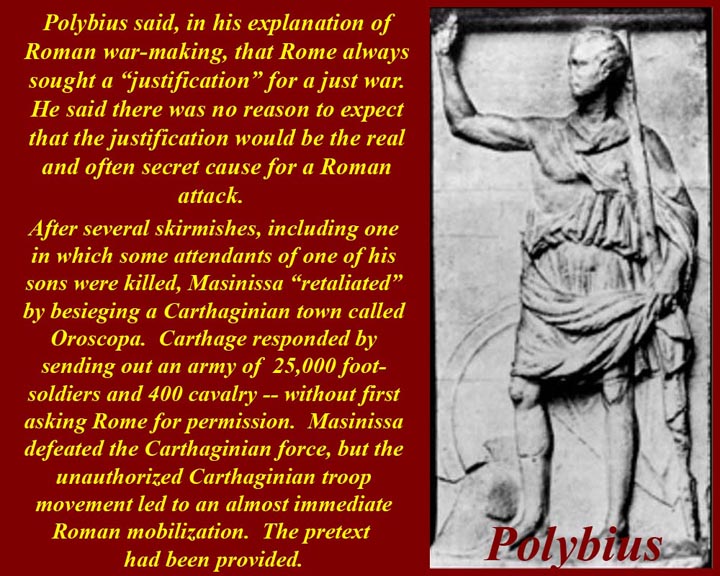
http://www.mmdtkw.org/CNAf0709PolybiusPretextVsCause.jpg
Polybius differentiated between pretexts and causes for Rome's wars. In this case, the pretext was Carthaginian reaction -- without Roman permission -- to one of Masinissas seizures.
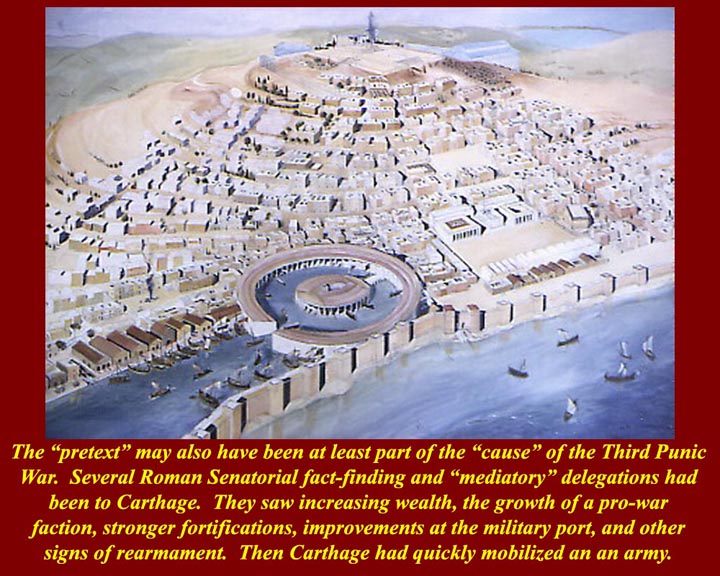
http://www.mmdtkw.org/CNAf0710RealCause3rdPunicWar.jpg
The pretext may have been a real part of the cause. Although Polybius says Rome had decided on war long before the Carthaginian army marched out to fight Masinissa (the Carthaginians lost), it suddenly had been proved that Carthage could quickly put a big army, equal to several Roman legions, in the field.
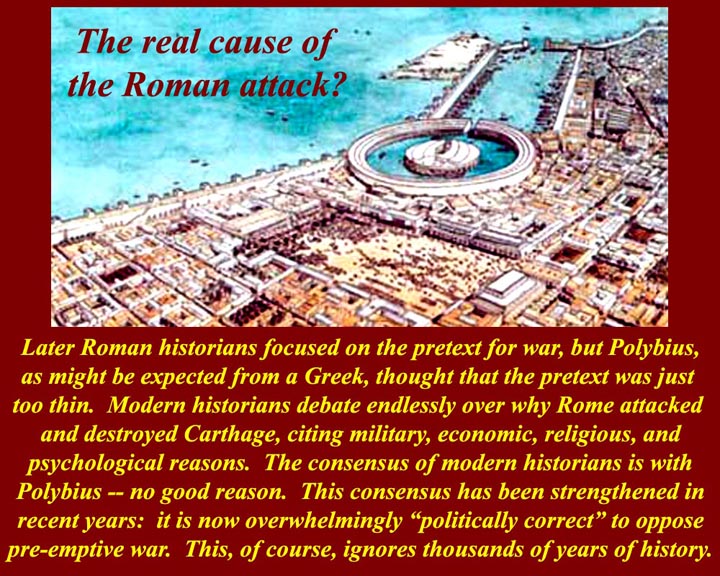
http://www.mmdtkw.org/CNAf0711RealCause2.jpg
Politically correct modern historians mostly agree with Polybius that the preemptive Roman declaration of war was unjustified. (In fact, Carthage had clearly violated the terms of the treaty it had been forced to accept at the end of the 2nd Punic War.)
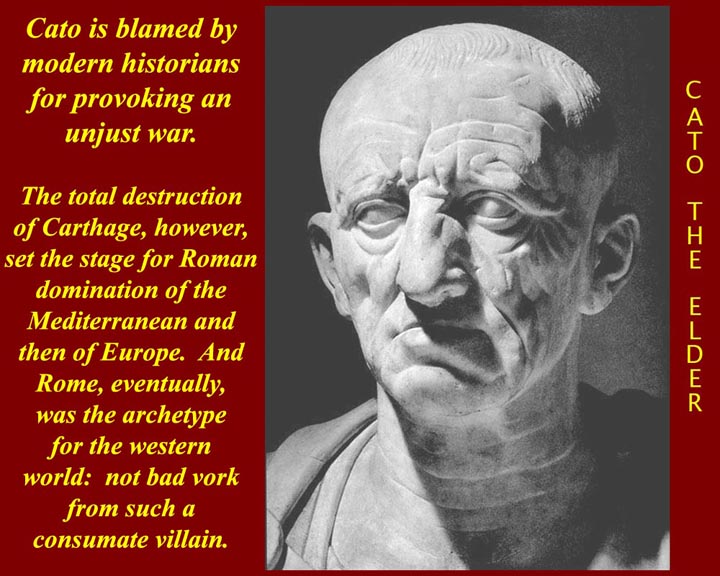
http://www.mmdtkw.org/CNAf0712VillainCato.jpg
Historians from Polybius until today have cast Cato as the villian of the piece, but, as we shall see, his misgivings about Carthaginian intentions were justified. His fears of the cult of personality exemplified by the Scipios in their dealing with the Roman army were also prophetic.
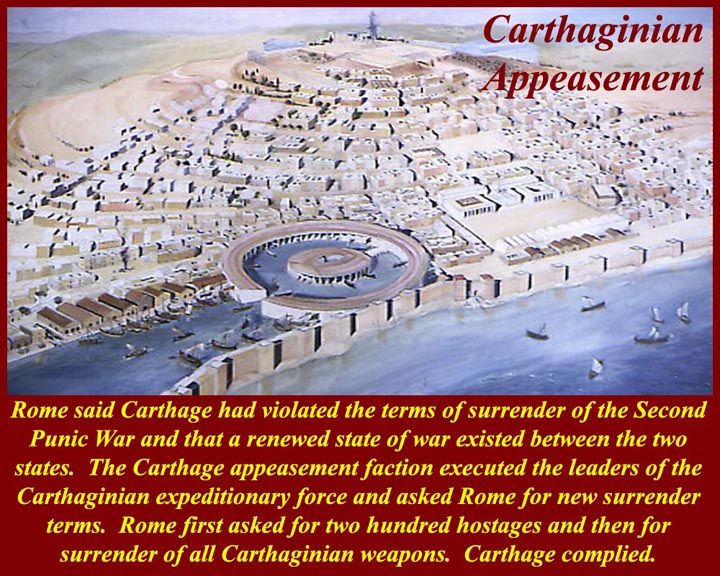
http://www.mmdtkw.org/CNAf0713CarthaginianAppeasement.jpg
The Carthaginian anti-war appeasement faction took over the city as soon as Rome announce the existence of a state of renewed war (actually resumption of hostilities of the Second Punic War). They agreed to hand over sons of 200 prominent families as hostages, and also turned over "all" their weapons and armor.
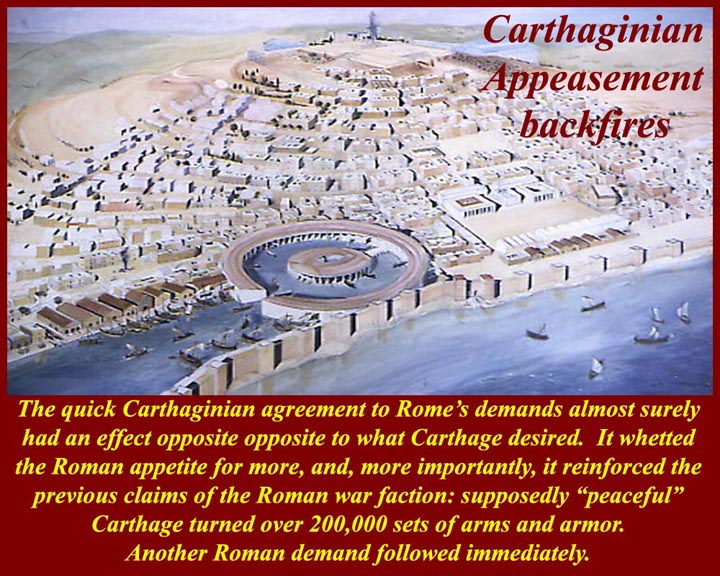
http://www.mmdtkw.org/CNAf0714AppeasementBackfires.jpg
Appeasement, as could be expected, whetted the Roman appetite. In addition, the turnover of enough weaponry to equip 200,000 troops ratified the claims of the Roman pro-war faction that Carthage was preparing for war.
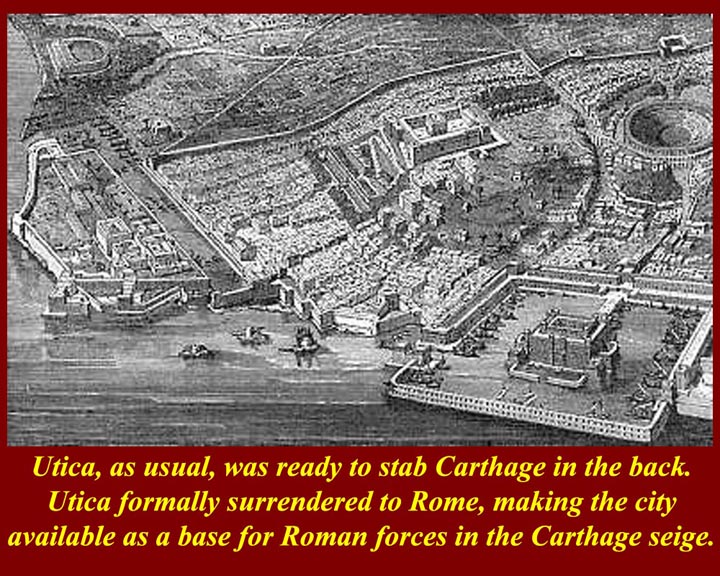
http://www.mmdtkw.org/CNAf0715UticaBackStab.jpg
Utica again stabbed Carthage in the back by abjectly surrendering to Rome. Utica thereafter became the base for the Roman expeditionary Consular armies.
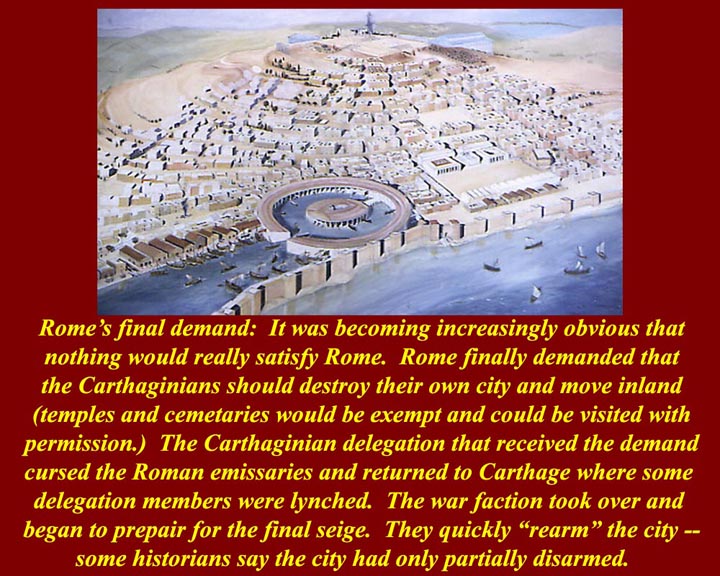
http://www.mmdtkw.org/CNAf0716RomeFinalDemand.jpg
Rome's final ultimatum was rejected: the Carthaginian negotiators refused to agree to the self-destruction of Carthage. They cursed the Romans and accurately predicted that they (the negotiators) would face a lynch mob when they made known the latest Roman demand.
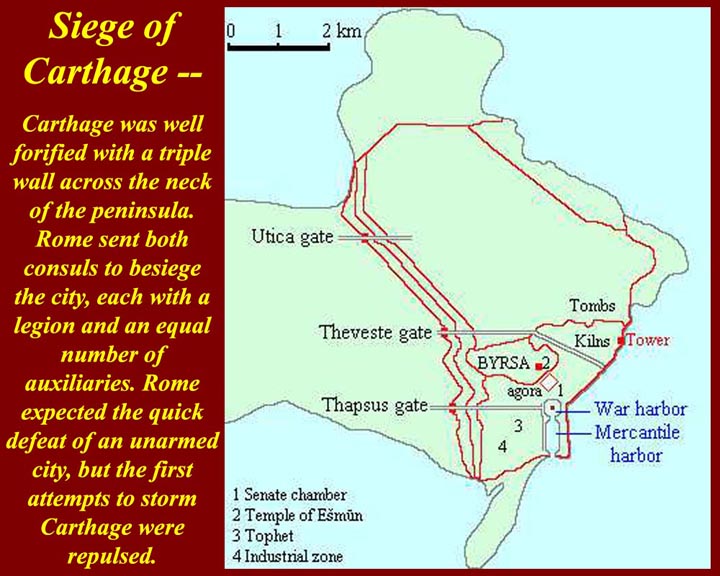
http://www.mmdtkw.org/CNAf0717CarthageBesieged.jpg
Both Consular armies besieged Carthage, but several attempts to take the supposedly disarmed city were repulsed by well-armed local militias. Appian records that the defenders quickly made new weapons, but at minimum that meant that they had held back a great deal of military raw materials (mostly metals) when they had supposedly surrendered all their weapons.
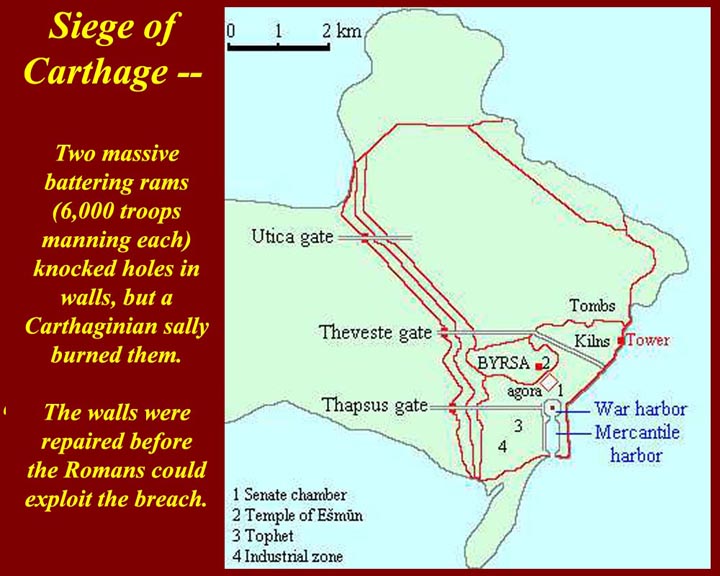
http://www.mmdtkw.org/CNAf0718BatteringRamsBurned.jpg
The Consuls built camps on the neck of land separating Carthage from the hinterland and constructed two massive battering rams (each "operated by 6000 men" -- perhaps an exageration). Holes were punched in the walls, but Roman troops could not flow through. Defenders sortied out and burned the machines.
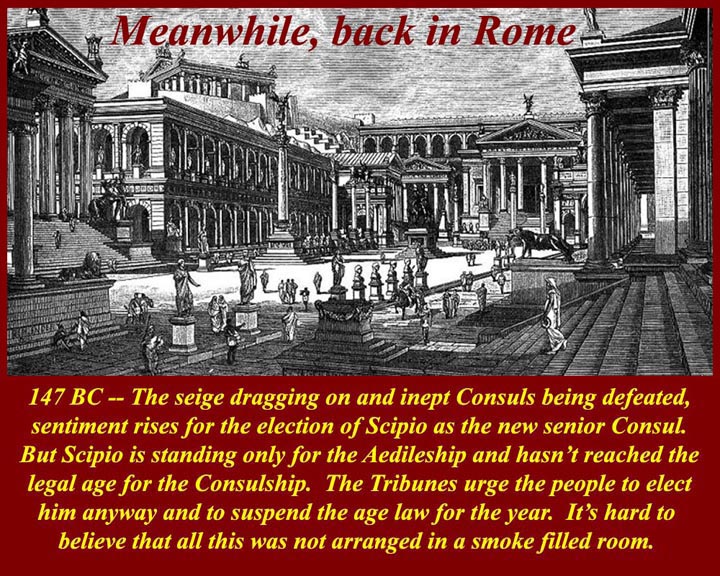
http://www.mmdtkw.org/CNAf0719ConsulScipio.jpg
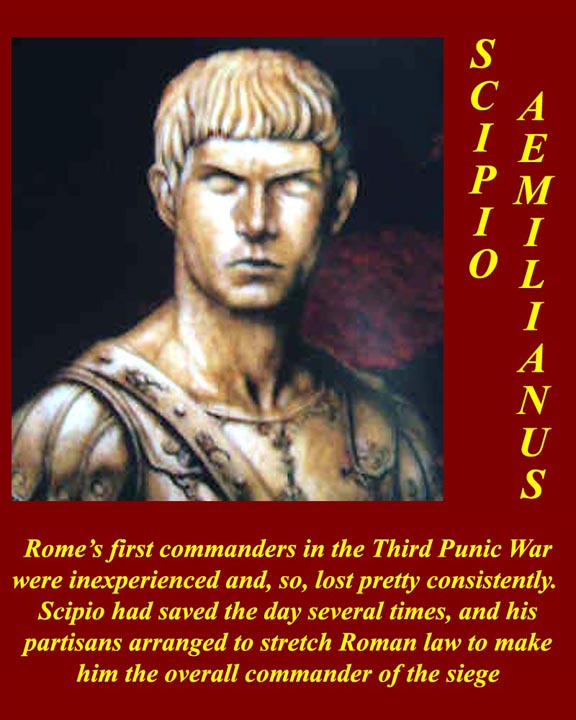
http://www.mmdtkw.org/CNAf0720CommanderScipio.jpg
Through maneuvering back in Rome, Scipio Aemilianus was elected Consul for 147 BC and given command of the expeditionary force. As a subaltern, he had already distinguished himself on several occasions in the North African campaign by rescuing Roman troops that had been unwisely hazarded by superior officers.
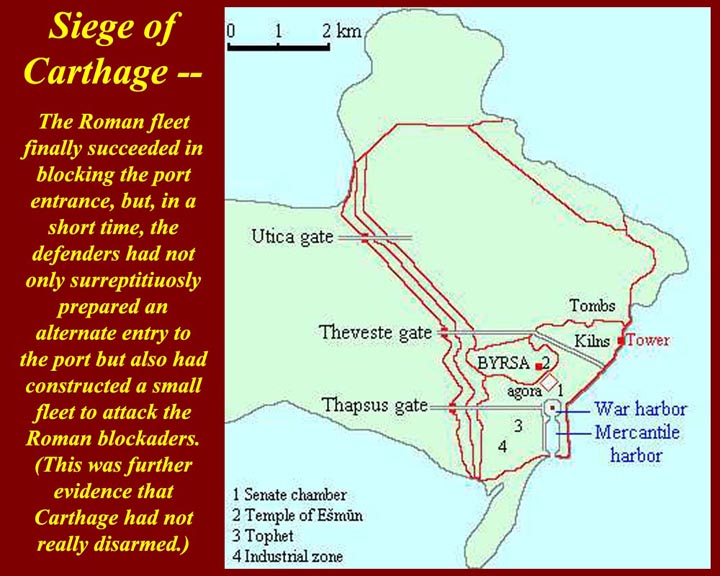
http://www.mmdtkw.org/CNAf0721BlockadeNavalSortie.jpg
Scipio first tightened discipline among the Roman troops and then tightened the land and sea blockades, making them really effective for the first time. But the defenders soon surreptitiously
built a new port entrance and a new fleet with which to attack the Roman sea blockade. The Carthaginan fleet was defeated, but, once again, Roman claims that Carthage had all along been getting ready to fight were justified -- we know, and certainly the Romans knew, that ships were built of prefabricated parts, which Carthage had clearly held in reserve.
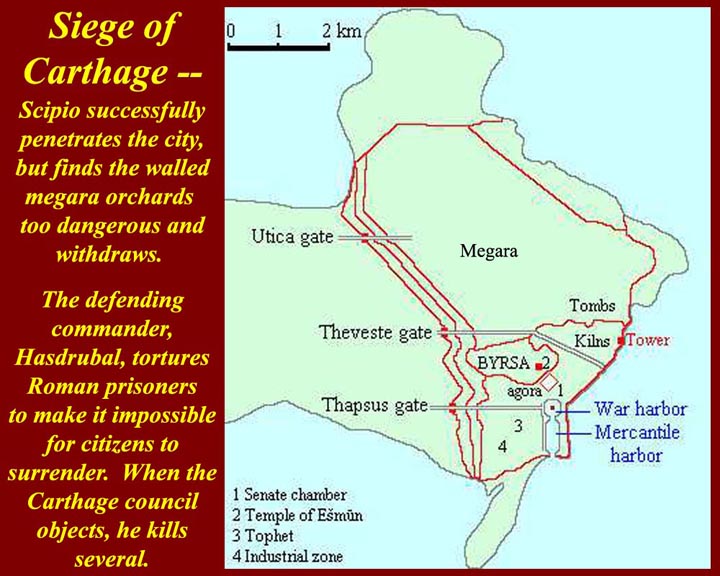
http://www.mmdtkw.org/CNAf0722RomansTortured.jpg
After Scipio successfully penetrated and withdrew from the northern Megara
area of the City, the enraged Carthaginian military commander, Hasdrubal, brutally tortured and killed Roman prisoners on the city walls. Moderns historians think he did this to make surrender impossible by the Carthaginian anti-war faction. When the city governing council objected, Hasdrubal executed several members.
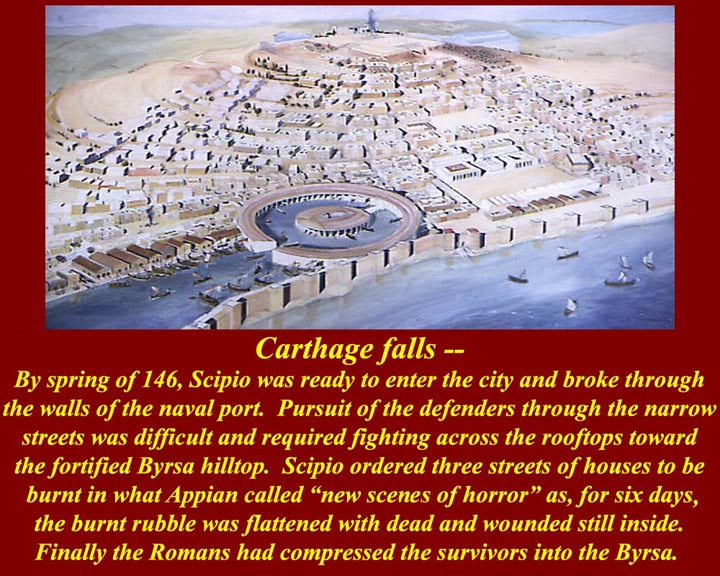
http://www.mmdtkw.org/CNAf0723CarthageFalls.jpg
In spring of 146 BC, Scipio's forces breached the walls of the circular naval port and began its six day march up to the top of the Byrsa Hill. Narrow streets made progress difficult, and troops had to move from house to house along rooftops. Scipio finally burned down three adjacent streets and then advanced up the hill buryiing dead and wounded Carthaginians in the flattened rubble. The whole remaining population of the city fled to the Byrsa.
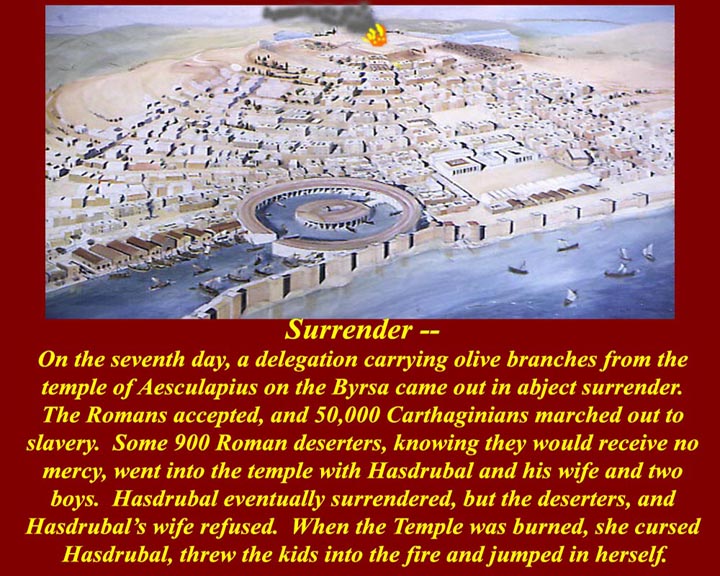
http://www.mmdtkw.org/CNAf0724CarthageSurrenders.jpg
On the seventh day, 50,000 Carthaginians surrendered carrying olive branches from the Temple of Aesculapius on the Byrsa Hill. They were sold into slavery. Hasdrubal and his wife and two young sons held out in the temple along with about 500 Roman army deserters who knew they would face instant execution. After a while, Hasdrubal surrendered, but his wife refused and cursed him for a coward. The Romans fired the temple, and the wife threw her children into the flames and leapt in after them. The deserters retreated to the temple roof where they too were consumed by the flames.
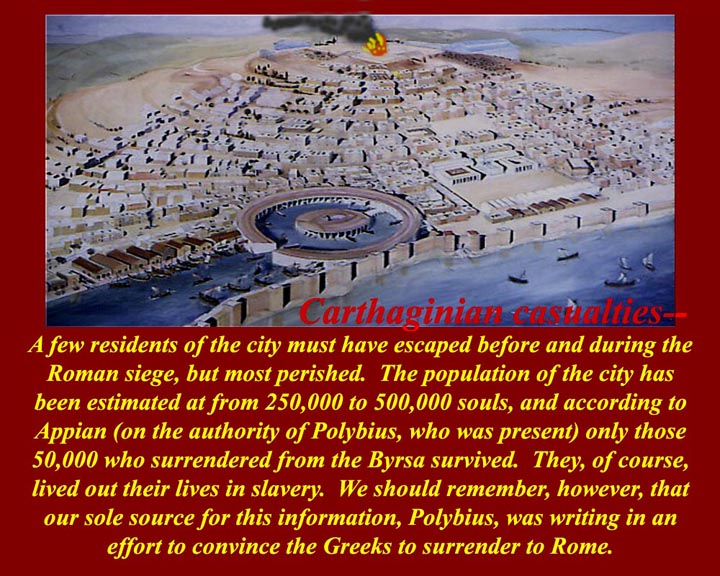
http://www.mmdtkw.org/CNAf0725CarthageCasualties.jpg
It's impossible to know how many Carthaginians were in the city at the beginning of the siege, but it's clear the Carthaginian civilian death toll was very high. Estimates of the total population of the city and suburbs in peacetime go as high as 700,000 (although that's probably a gross exaggeration).
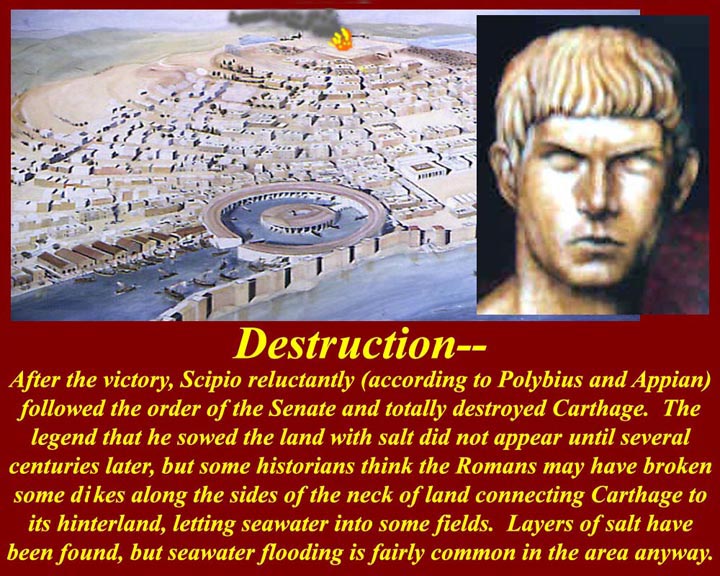
http://www.mmdtkw.org/CNAf0726CarthageDestroyed.jpg
Scipio, according to Polybius and Appian, reluctantly carried out the orders of the Roman Senate to destroy the city -- he is said to have recited an Homeric couplet about the fall of Troy, supposedly showing his feeling that all empires eventually fall. Appian says that Polybius was at Scipio's side when Scipio said the words.
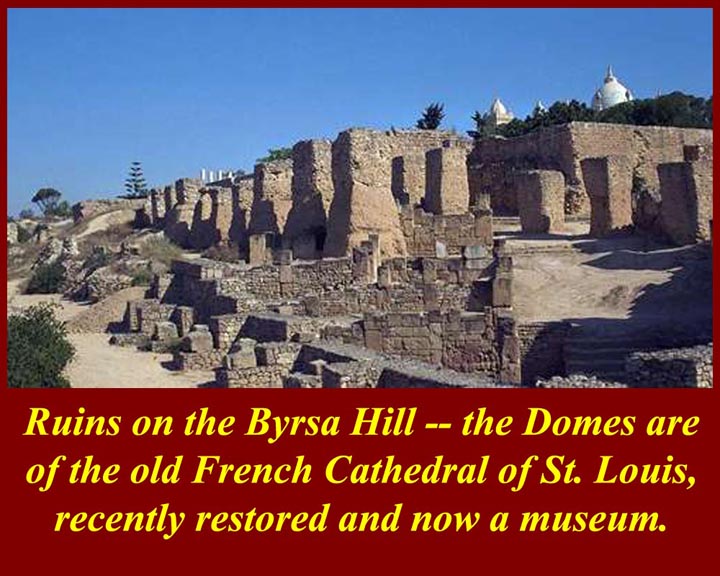
http://www.mmdtkw.org/CNAf0727ByrsaRuins.jpg
A few Carthaginian ruins are still visible on the side of the Byrsa Hill. The Romans burned the hilltop temple and later flattened the hill itself for later construction. A recently restored but desacralized 1890 French Basilica which was dedicated to St. Louis stands on the site now and is used for concerts and cultural events.
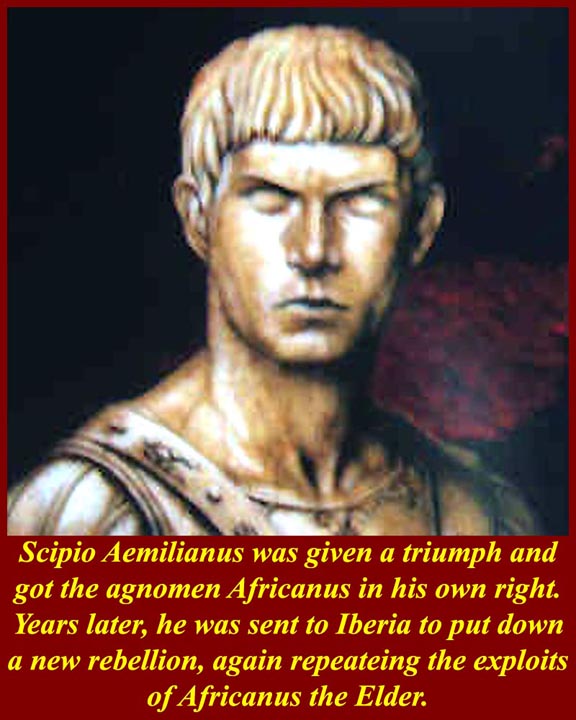
http://www.mmdtkw.org/CNAf0728ScipioAfricanusMinor.jpg
Scipio Aemilianus quickly was granted a victor's triumph in Rome and was awarded the agnomen Africanus in his own right. The deceased earlier Africanus was thereafter know as "the Elder" while Aemilianus was designated "the Younger." His services were required again several years later in Iberia where his conquests became the two additional new provinces of "closer" and "farther" Hispania.
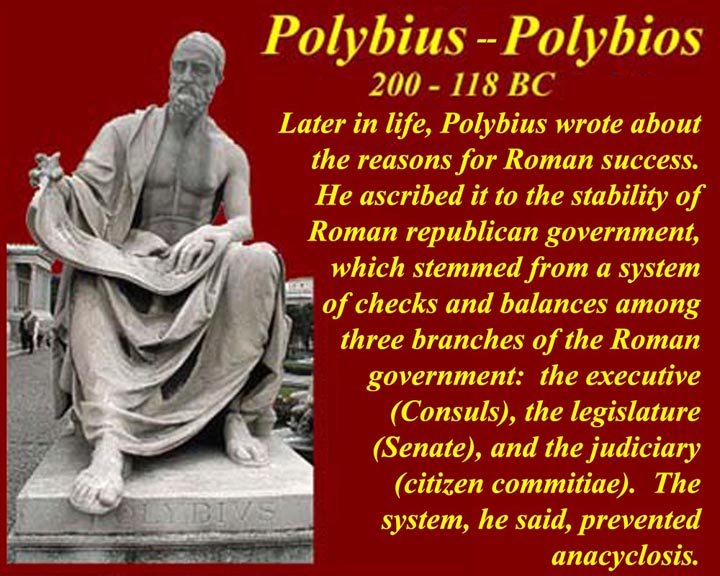
http://www.mmdtkw.org/CNAf0729PolybiusRomanStability.jpg
Polybius went on to write his history of Roam conquests up to his time. His history included an explanation for his Greek audience of why the stability of Rome's tripartite Republican government made Rome invincible. He might have thought otherwise one hundred years later then the real conquests began sans republic.
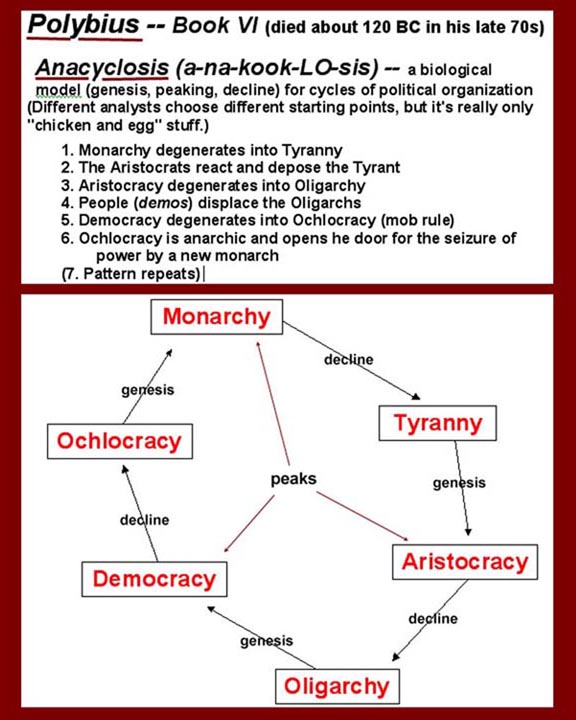
http://www.mmdtkw.org/CNAf0730PolybiusAnacyclosis.jpg
Polybius said that in "simple governments" anacyclosis (see image) was an inevitable cycle in which mob democracy led to mob rule followed by monarchy, tyranny, aristocracy, plutocracy, the again to democracy, etc., in a never ending circular progression.
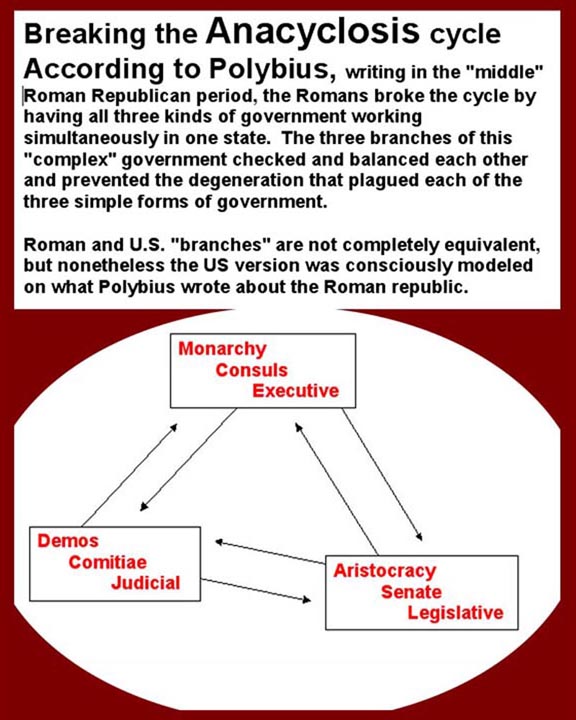
http://www.mmdtkw.org/CNAf0731BreakingAnacyclosis.jpg
The Roman Republic, according to Polybius, had figured uot how to avoid the three bad parts of anacyclosis -- mob rule, tyranny, and oligarchy -- by similtaneously having a monarchichal executive branch (actually a duarchy, two co-equal Consuls), an aristocratic legislature (Senate), and a democratic civil court system (the public Comitiae). The three branches naturally checked and balanced each other. If that sounds familiar, it's because the framers of the US Constitution had multiple copies of Polybius at the Constitutional Convention of 1789, thoughtfully provided by Jefferson who was, at the time, the US ambassador in Paris. Some moderns historians credit Charles-Louis de Secondat, Baron de La Brède et de Montesquieu (usually simply "Montesquieu"), with being the originator of the idea of thre branches of government and "checks and balances". In fact, Montesquieu credits the idea to Polybius. Jefferson knew this and sent to the Constitutional Convention copies of the theorizing of both Polybius and Montesquieu.
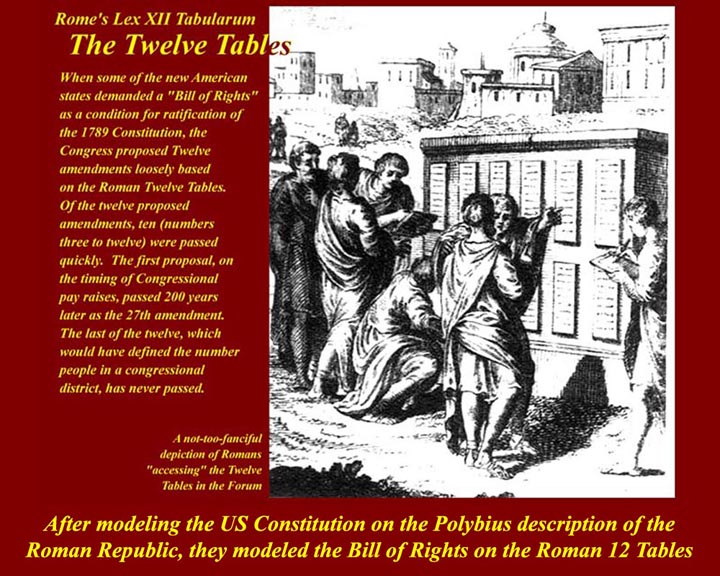
http://www.mmdtkw.org/CNAf0732TwelveTables.jpg
Later, the American "Founding Fathers" also emulated the Roman "Twelve Tables" when they pusued and adopted the American Bill of Rights -- there were originally to be twelve amendments in the Bill of Rights but only ten were agreed upon. An eleventh of the proposed twelve ammendments later became the 27th Amendment. It dealt with congressional pay raises. The twelfth, which would have mandated representation "by the numbers" rather than proportional representation, never passed.
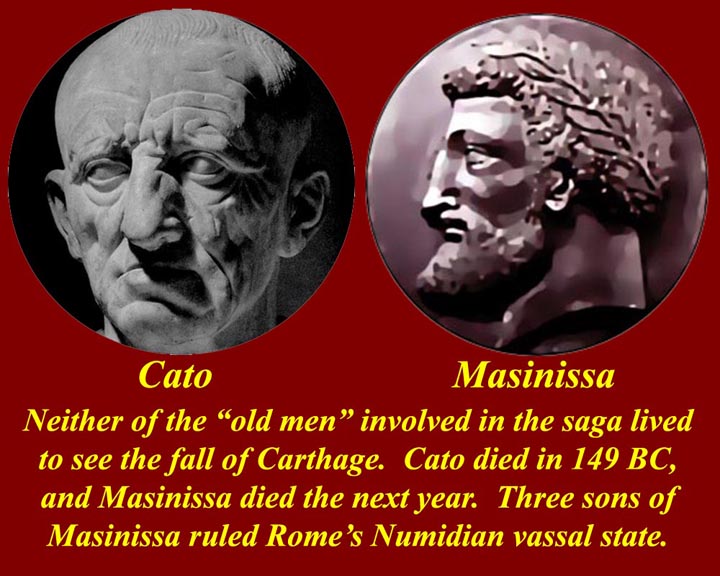
http://www.mmdtkw.org/CNAf0733CatoMasinissa Dead.jpg
Niether Cato nor Masinissa, the two "old men" involved in the saga, lived through the 3rd Punic War.
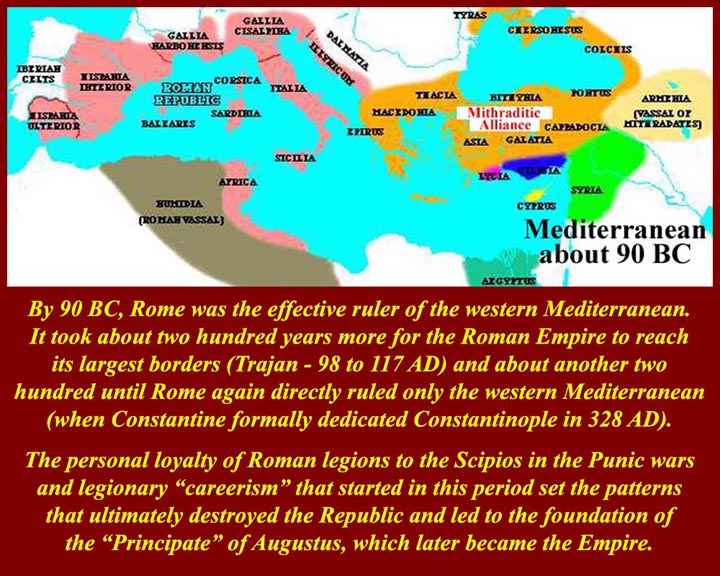
http://www.mmdtkw.org/CNAf0734RomanWestMed.jpg
By 90 AD, Rome had control of the western Mediterranean.
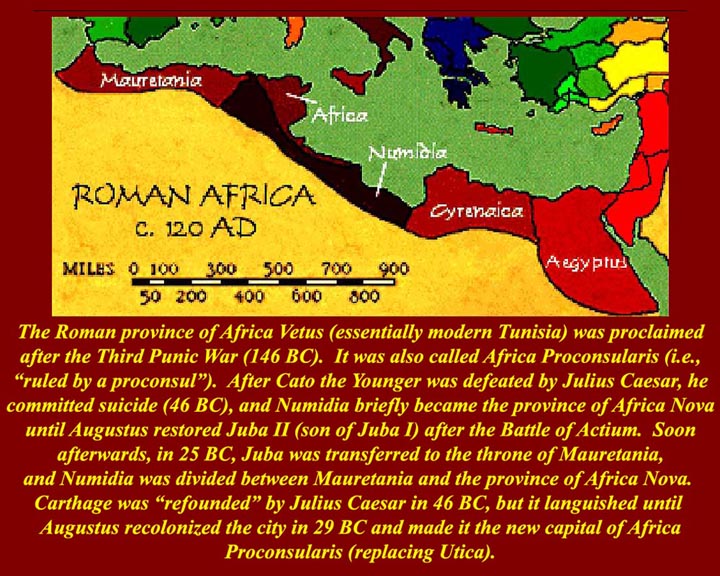
http://www.mmdtkw.org/CNAf0735RomanAfrica.jpg
Roman North Africa -- the subject of the next unit.
